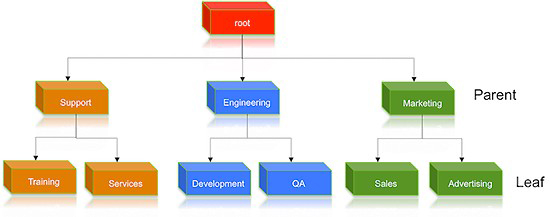Setting up Queues
The fundamental unit of scheduling in YARN is a queue. The capacity of each queue specifies the percentage of cluster resources that are available for applications submitted to the queue. Queues can be set up in a hierarchy that reflects the database structure, resource requirements, and access restrictions required by the various organizations, groups, and users that utilize cluster resources.
For example, suppose that a company has three organizations: Engineering, Support, and Marketing. The Engineering organization has two sub-teams: Development and QA. The Support organization has two sub-teams: Training and Services. And finally, the Marketing organization is divided into Sales and Advertising. The following image shows the queue hierarchy for this example:

Each child queue is tied to its parent queue with the yarn.scheduler.capacity.<queue-path>.queues configuration property in the capacity-scheduler.xml file. The top-level "support", "engineering", and "marketing" queues would be tied to the "root" queue as follows:
Property: yarn.scheduler.capacity.root.queues
Value: support,engineering,marketing
Example:
<property> <name>yarn.scheduler.capacity.root.queues</name> <value>support,engineering,marketing</value> <description>The top-level queues below root.</description> </property>
Similarly, the children of the "support" queue would be defined as follows:
Property: yarn.scheduler.capacity.support.queues
Value: training,services
Example:
<property> <name>yarn.scheduler.capacity.support.queues</name> <value>training,services</value> <description>child queues under support</description> </property>
The children of the "engineering" queue would be defined as follows:
Property:
yarn.scheduler.capacity.engineering.queues
Value: development,qa
Example:
<property> <name>yarn.scheduler.capacity.engineering.queues</name> <value>development,qa</value> <description>child queues under engineering</description> </property>
And the children of the "marketing" queue would be defined as follows:
Property:
yarn.scheduler.capacity.marketing.queues
Value: sales,advertising
Example:
<property> <name>yarn.scheduler.capacity.marketing.queues</name> <value>sales,advertising</value> <description>child queues under marketing</description> </property>
Hierarchical Queue Characteristics
There are two types of queues: parent queues and leaf queues.
Parent queues enable the management of resources across organizations and sub- organizations. They can contain more parent queues or leaf queues. They do not themselves accept any application submissions directly.
Leaf queues are the queues that live under a parent queue and accept applications. Leaf queues do not have any child queues, and therefore do not have any configuration property that ends with ".queues".
There is a top-level parent root queue that does not belong to any organization, but instead represents the cluster itself.
Using parent and leaf queues, administrators can specify capacity allocations for various organizations and sub-organizations.
Scheduling Among Queues
Hierarchical queues ensure that guaranteed resources are first shared among the sub-queues of an organization before any remaining free resources are shared with queues belonging to other organizations. This enables each organization to have control over the utilization of its guaranteed resources.
At each level in the hierarchy, every parent queue keeps the list of its child queues in a sorted manner based on demand. The sorting of the queues is determined by the currently used fraction of each queue’s capacity (or the full-path queue names if the reserved capacity of any two queues is equal).
The root queue understands how the cluster capacity needs to be distributed among the first level of parent queues and invokes scheduling on each of its child queues.
Every parent queue applies its capacity constraints to all of its child queues.
Leaf queues hold the list of active applications (potentially from multiple users) and schedules resources in a FIFO (first-in, first-out) manner, while at the same time adhering to capacity limits specified for individual users.

